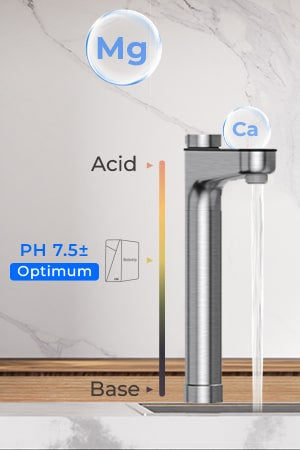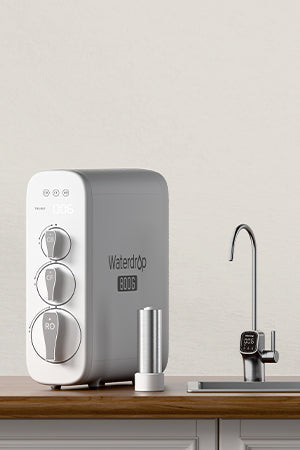The effects of contamination in household water are well documented.
US Centers for Disease Control and Prevention states:
"Contaminants in our water can lead to health problems, including
gastrointestinal diseases, reproductive problems and neurological disorders." And further: "Infants,
Young children, pregnant women, the elderly and people with weakened immune systems are at increased risk,
to become ill after drinking contaminated water."
As important as it may be, clean water is not an option for many people
The World Health Organization reports that "contaminated drinking water is
an estimated
485,000 deaths caused by diarrhoeal diseases."
Although governments and local authorities would have us believe that the water,
that flows from our taps is clean, there is no way for a layman to know whether this
is actually the case. For this reason, many people turn to reverse osmosis (RO) to find certainty
have.
This article answers some frequently asked questions about reverse osmosis.
What is reverse osmosis?
To get a better idea of the concept of
reverse osmosis , we should
first define osmosis.
The Encyclopaedia Britannica defines
osmosis as "the spontaneous passage or
Diffusion of water or other solvents through a semipermeable membrane". The same
Information database adds that a semipermeable membrane is "a membrane that allows the passage of
dissolved substances blocked", ie by dissolved substances.
Osmosis is a natural process. The best example of naturally occurring
Osmosis is when plant roots absorb water from the soil. Reverse osmosis, on the other hand, is a technology
which uses the same principle as natural osmosis. However, in reverse osmosis, the water is not
naturally through the semi-permeable membrane. It is pressed through the membrane under pressure.
The difference between osmosis and reverse osmosis is that in
Osmosis moves the clean water towards the contaminated water. In reverse osmosis, this model is
upside down. It moves the clean water from the contaminated side to the side with more clean
Water.
How does reverse osmosis work?
Domestic water is supplied under pressure; this is how it reaches your home, whether
You live in a valley or in a high-rise building. Reverse osmosis uses this pressure to
through a semi-permeable membrane.
When the water is pressed through the semi-permeable membrane, it
Impurities remain on the other side of the membrane. This ensures that the water coming from
your faucet is the cleanest you can get. To ensure that the
Reverse osmosis systems produce as clean water as possible, many of these systems include several
filter levels, sometimes up to seven.
What about tankless reverse osmosis systems?
However, it has been found that reverse osmosis systems that use a tank
have a disadvantage. If they are not regularly rinsed and cleaned, such systems can
become a breeding ground for bacteria. In addition, such a system can cause air to evaporate due to the rubber that
Water separates, producing water with a foul odor.
Fortunately, technology has solved the problems of reverse osmosis systems with tanks
by introducing a new generation of efficient reverse osmosis systems that do not require a storage tank
Such a system—the so-called tankless reverse osmosis system—is more efficient. Compared to
Compared to traditional tank systems, the system wastes less water.
Apart from the fact that no water needs to be stored, which could potentially
breeding ground for bacteria and putrefactive organisms, tankless systems offer a number of other advantages:
You save costs because water is only produced when it is needed.
You do not have to wait for the water in the tank to build up when the water in the tank is used up
is.
The water tastes better than that produced by conventional reverse osmosis systems.
It saves the space that the tank would otherwise have taken up.
Where is reverse osmosis used?
RO is used in both domestic and industrial areas. In
In the domestic sector, the process is used to supply households with clean water. It is
preferred by those who want to be sure that the water they drink has an additional
has passed through the cleaning stage.
Reverse osmosis can also be used if you are sure that the water,
that you drink has not been processed, for example when camping.
In industry, reverse osmosis is used for large projects such as the purification of
Seawater is used through a process called desalination. It is also used in industries
whose activities pollute the water, e.g. in mining. By treating water with
With the help of reverse osmosis, water that would otherwise be unsuitable for drinking can be made safe and drinkable
become.
What are the basic components of an RO system?
An RO system consists of several essential components:
Cold water line valve: Is the valve that controls the water coming from the
main line into the RO system.
Reverse osmosis membrane: This is the part that separates the water from the impurities
separates.
Filter: The reverse osmosis system uses several filters before the water
finally reaches the pressure tank from which it can be used. The pre-filters treat the water on
the way from the main supply to the storage tank. The post-filters treat the water one last time before
it is used.
Storage tank: The filtered water is stored in a storage tank. Some
Systems do not use a tank. These tanks, which come in different sizes, are under pressure. The
Reverse osmosis system has a device that interrupts the flow of water through the membrane,
as soon as the tank fills up.
Check valve : Since the treated water is kept under pressure, the
Check valve ensures that it does not flow back from the reverse osmosis tank. If the treated water
If the water were to flow back, this would damage the membrane.
Flow restrictor: The water flowing through a membrane is under pressure.
This pressure is regulated so that all impurities are retained. The flow restrictor regulates
this pressure.
Drain line: The collected impurities must eventually leave the RO system
This happens via the drain line.
How many stages does an RO system have?
In general, the RO system includes four stages:
Sediment filter: Ensures that large particles that the reverse osmosis membrane
could damage are removed early in the process.
Carbon filter: Also serves to protect the RO membrane by removing chlorine and other
Impurities are removed. In this phase, unpleasant odors are removed and the taste of the water
improved.
Reverse osmosis membrane: This is the main stage in which almost all remaining
Contaminants are removed from the water.
Polishing filter: This step takes place shortly before using the water. It serves
to remove any remaining contaminants and bad odors one last time.
Which pollutants are removed by RO systems?
The website RO-System.org, which helps consumers find the best water filter systems
lists some of the pollutants removed by RO:
| Lead |
cadmium |
| arsenic |
phosphate |
| nitrates |
radium |
| nitrites |
chlorine |
| chrome |
barium |
| selenium |
bacteria |
| fluoride |
cysts |
| viruses |
mercury |
What are the benefits of using an RO system?
An effective RO system can remove up to 99% of known contaminants from the
water. Below are some of the benefits of an RO system:
Reduces the amount of harmful chemicals dissolved in the water.
Provides clean water in areas where it is impossible to obtain treated water, e.g.
on camping trips.
Removes odors and bad tastes.
It is easy to install and requires little maintenance.
Designed for connection to the existing water supply.
is more environmentally friendly than bottled water.
What are the advantages of RO over other water filtration systems?
In general, reverse osmosis consumes less water than other
Water filtration systems use less energy. The system can save energy because it is more efficient.
Saving energy means you get clean water for less money.
Reverse osmosis systems can be built smaller than other water filter systems.
This means that they take up less space. In addition, the space they take up under the sink is often
not used productively for other purposes. Some reverse osmosis systems do not require a tank, which also saves space.
The system is also easy to maintain.
Does RO have an impact on the environment?
A common problem with RO systems is the amount of water that is
Wastewater has to be disposed of. However, there is a solution to this challenge. Wastewater can be used for
other purposes, such as cleaning and flushing the toilet.
Like all other systems, reverse osmosis has an impact on the environment.
However, these impacts are small compared to alternatives such as bottled water.
How long is the lifespan of a reverse osmosis system?
In general, a reverse osmosis system is designed for a service life of 10 to 15
years. However, it is important to remember that the system, like all other machines,
has certain consumables that need to be replaced at regular intervals. These include the
filter and the membrane.
In general, the filters need to be changed once or twice a year.
Membrane, on the other hand, has a longer lifespan, which is between two and four years. The lifespan of the
Membrane depends on the water conditions in which the membrane is used.
What factors should I consider when choosing the best RO system?
Although the main functions of a reverse osmosis system are the same,
Not all systems are the same. Most of the time the difference lies in the quality of the components used in the
used to produce a specific system.
When looking for a reverse osmosis system, you should consider the following points
observe:
Number of filter stages; the more stages, the better.
Efficiency, measured by the amount of water the RO system can produce per day.
user reviews.
Efficiency in removing pollutants, measured as the percentage of pollutants removed.
The technology and quality of the parts used. Do the parts meet any quality standards
supported by the industry?
reputation of the manufacturer.
How difficult is it to maintain the RO system?
The RO system is relatively easy to maintain. If you want your system to be as
long as possible, remember to change the filters when necessary.
To facilitate filter replacement, some sophisticated
Reverse osmosis systems are now equipped with sensors that indicate via an LED light that it is time
to change the filter. However, the easiest way is to follow the manufacturer's instructions.
In general, reverse osmosis systems are designed so that the filters without
Tools can be changed. If tools are required, they are usually provided by the manufacturers
of the system upon delivery of your reverse osmosis system.































































